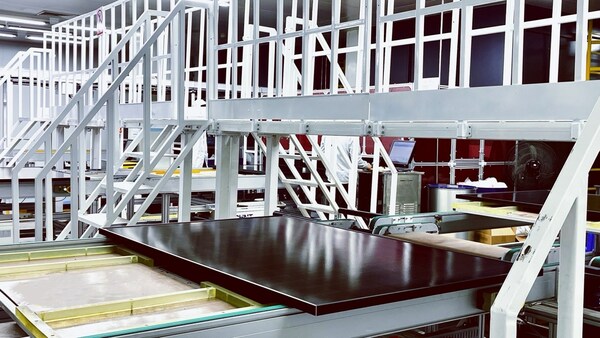Astronergy, the module production unit of Chint Group, announced it started the first shipments of its new tunnel oxide passivated contact (TOPCon) ASTRO N7s ZBB-TF modules to Europe.
The ASTRO N7s ZBB-TF panel is fabricated without busbars, based on zero busbar (ZBB) interconnection technology.
“Astronergy is one of the first companies in the industry to apply ZBB technology to the TOPCon technology route and achieve mass production,” Astronergy's product marketing executive Peter Li, told pv magazine.“By applying ZBB technology, there are no main grid lines and no pad points on the front and back of the cell, which effectively reduces 20% of the amount of silver paste compared to super multibusbar (SMBB) processes, which improves the aesthetics.”
According to Li, the usage of more and finer welding wires makes the stress distribution more uniform and mitigates the risk of hidden cracks in the process.
“The ZBB technology is known for its ability to increase conversion efficiency by eliminating shading caused by busbars,” TÜV Rheinland’s Christos Monokroussos told pv magazine. It supports better current carrier collection efficiency and improved aesthetics.
The module also integrates a tiling film (TF), which is used to hold solder strips and solar cells in place during the subsequent lamination process. It protects the overlapping area of adjacent cells, reducing the chances of cracking, according to the manufacturer.
The bifacial ASTRO N7s ZBB-TF modules feature 108 n-type TOPCon cells. The modules also feature front and back glass with a thickness of 1.6 mm and a black anodized aluminum frame. They measure 1,762 mm x 1,134 mm x 30 mm and weigh 21.5 kg.
Popular content
The new panels are available in five versions with power outputs ranging from 440 W to 460 W. The power conversion efficiency spans from 22.0% to 23.0%. The open-circuit voltage is between 38.80 V and 39.60 V, while the short-circuit current is between 14.18 A and 14.52 A.
The products operate with a maximum system voltage of 1,500 V and have an IP68 junction box. They have a temperature coefficient of -0.29% per C.
The manufacturer offers a 30-year linear power output warranty, a 15-year product warranty, and an optional 25-year warranty for rooftop applications. The degradation in the first year is purportedly 1% and the 30-year end power output is guaranteed to be no less than 87.4% of the nominal output power.
TÜV Rheinland has certified the panels.
The shipment news signals mass production for a model with a reported efficiency of 23%, suitable for residential and distributed generation markets.
For now, the modules featuring the ZBB and TF technologies are only available for residential applications, according to Li. The company, however, may consider bringing them to the commercial and industrial (C&I) markets if demand emerges.
This content is protected by copyright and may not be reused. If you want to cooperate with us and would like to reuse some of our content, please contact: editors@pv-magazine.com.


1 comment
By submitting this form you agree to pv magazine using your data for the purposes of publishing your comment.
Your personal data will only be disclosed or otherwise transmitted to third parties for the purposes of spam filtering or if this is necessary for technical maintenance of the website. Any other transfer to third parties will not take place unless this is justified on the basis of applicable data protection regulations or if pv magazine is legally obliged to do so.
You may revoke this consent at any time with effect for the future, in which case your personal data will be deleted immediately. Otherwise, your data will be deleted if pv magazine has processed your request or the purpose of data storage is fulfilled.
Further information on data privacy can be found in our Data Protection Policy.